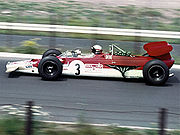
Lotus 63
Encyclopedia
The Lotus 63 was an experimental Formula One
car, designed by Colin Chapman
and Maurice Philippe
for the 1969 season. Chapman's reasoning behind the car was that the 3 litre engines introduced in 1966 would be better served by building a car that could take full advantage of its power while retaining the Lotus 49
's simplicity.
As the Lotus 56
for Indy 500 (and later F1), the 63 chassis was designed around a four wheel drive
system. This was no revolution at the time, as four wheel drive had been used on the Ferguson P99 F1 car that won at Oulton Park
as early as 1961. However, it was not a successful design. In fact, the Matra
MS84 was the only 4WD F1 which scored points with Johnny Servoz-Gavin
, something neither Lotus nor McLaren managed, while Cosworth
did not even race their 4WD design. The 63 was an evolution of the 49, but featured wedge shaped rear bodywork and integrated wings, which would be used to great effect in the Lotus 72
.
 John Miles
John Miles
, Lotus' third driver was entrusted the task of developing the car, while Graham Hill
and Jochen Rindt
used the 49 in the early races of 1969. The car proved extremely difficult to drive and set up, and the four wheel drive system was especially problematic. After a single test run, Hill flatly refused to drive the car again stating it was a 'deathtrap,' as did Rindt, who agreed with Hill after taking the car to its best result, 2nd in the non-championship Oulton Park Gold Cup. This infuriated Chapman as he saw the 63 as another quantum leap ahead of its rivals, just as its predecessors had been.
The car was entered at the 1969 British Grand Prix
as a test run. Whilst Rindt finished fourth in the older 49 behind Jackie Stewart
, Miles could only bring the 63 home in 10th place, confirming the car's uncompetitiveness. After several other fruitless outings, the 63 was abandoned, but parts of the chassis design were worked into the Lotus 72, which debuted in 1970.
The four wheel drive technology returned into F1 with the Lotus 56
B in 1971.
Like the Lotus 88
, the 4WD cars proved to be huge white elephants for Lotus, but it paved the way for better models to follow.
Formula One
Formula One, also known as Formula 1 or F1 and referred to officially as the FIA Formula One World Championship, is the highest class of single seater auto racing sanctioned by the Fédération Internationale de l'Automobile . The "formula" designation in the name refers to a set of rules with which...
car, designed by Colin Chapman
Colin Chapman
Anthony Colin Bruce Chapman CBE was an influential British designer, inventor, and builder in the automotive industry, and founder of Lotus Cars....
and Maurice Philippe
Maurice Philippe
Maurice Philippe, also known as Maurice Phillippe, was a British aircraft and Formula One car designer.Philippe designed his first car in 1955, called the MPS , while employed developing the Comet 4 aircraft for De Havilland....
for the 1969 season. Chapman's reasoning behind the car was that the 3 litre engines introduced in 1966 would be better served by building a car that could take full advantage of its power while retaining the Lotus 49
Lotus 49
The Lotus 49 was a Formula One racing car designed by Colin Chapman and Maurice Philippe for the 1967 F1 season. It was designed around the Cosworth DFV engine that would power most of the Formula One grid through the 1970s and was the first successful Formula One car to feature the engine as a...
's simplicity.
As the Lotus 56
Lotus 56
The Lotus 56 was a racing car, designed by Maurice Philippe as Team Lotus' 1968 entry in the Indianapolis 500, replacing the successful Lotus 38. The Lotus 56 was not based on the STP-Paxton Turbocar that almost won in 1967, but was an entirely new and more advanced design...
for Indy 500 (and later F1), the 63 chassis was designed around a four wheel drive
Four Wheel Drive
The Four Wheel Drive Auto Company, more often known as Four Wheel Drive or just FWD, was founded in 1909 in Clintonville, Wisconsin, as the Badger Four-Wheel Drive Auto Company by Otto Zachow and William Besserdich.-History:...
system. This was no revolution at the time, as four wheel drive had been used on the Ferguson P99 F1 car that won at Oulton Park
Oulton Park
Oulton Park Circuit is a motor racing track in the small village of Little Budworth, Cheshire, England. It is about from Winsford, from Chester city centre, from Northwich and from Warrington with a nearby rail connection along the Mid-Cheshire Line. It occupies much of the area which was...
as early as 1961. However, it was not a successful design. In fact, the Matra
Matra
Mécanique Aviation Traction or Matra was a French company covering a wide range of activities mainly related to automobile, bicycles, aeronautics and weaponry. In 1994, it became a subsidiary of the Lagardère Group and now operates under that name.Matra was owned by the Floirat family...
MS84 was the only 4WD F1 which scored points with Johnny Servoz-Gavin
Johnny Servoz-Gavin
Georges-Francis "Johnny" Servoz-Gavin was a motor racing driver in both sportscars and single seaters....
, something neither Lotus nor McLaren managed, while Cosworth
Cosworth
Cosworth is a high performance engineering company founded in London in 1958, specialising in engines and electronics for automobile racing , mainstream automotive and defence industries...
did not even race their 4WD design. The 63 was an evolution of the 49, but featured wedge shaped rear bodywork and integrated wings, which would be used to great effect in the Lotus 72
Lotus 72
The Lotus 72 was a Formula One car designed by Colin Chapman and Maurice Philippe of Lotus for the 1970 Formula One season.- Development :The 72 was yet another innovative design by Chapman featuring inboard brakes, side mounted radiators in sidepods, as opposed to the nose mounted radiators which...
.

John Miles (auto racer)
John Miles is a British former racing driver from England. He participated in 15 Formula One World Championship Grands Prix, making his debut on July 6, 1969. He scored a total of 2 championship points...
, Lotus' third driver was entrusted the task of developing the car, while Graham Hill
Graham Hill
Norman Graham Hill was a British racing driver and two-time Formula One World Champion. He is the only driver to win the Triple Crown of Motorsport — the 24 Hours of Le Mans, Indianapolis 500 and Formula One World Championship.Graham Hill and his son Damon are the only father and son pair both to...
and Jochen Rindt
Jochen Rindt
Karl Jochen Rindt was a German racing driver who represented Austria during his career. He is the only driver to posthumously win the Formula One World Drivers' Championship , after being killed in practice for the Italian Grand Prix...
used the 49 in the early races of 1969. The car proved extremely difficult to drive and set up, and the four wheel drive system was especially problematic. After a single test run, Hill flatly refused to drive the car again stating it was a 'deathtrap,' as did Rindt, who agreed with Hill after taking the car to its best result, 2nd in the non-championship Oulton Park Gold Cup. This infuriated Chapman as he saw the 63 as another quantum leap ahead of its rivals, just as its predecessors had been.
The car was entered at the 1969 British Grand Prix
1969 British Grand Prix
The 1969 British Grand Prix was a Formula One motor race held at the Silverstone Circuit on July 19, 1969. It was the sixth round of the 1969 Formula One season...
as a test run. Whilst Rindt finished fourth in the older 49 behind Jackie Stewart
Jackie Stewart
Sir John Young Stewart, OBE , better known as Jackie Stewart, and nicknamed The Flying Scotsman, is a Scottish former racing driver and team owner. He competed in Formula One between 1965 and 1973, winning three World Drivers' Championships. He also competed in Can-Am...
, Miles could only bring the 63 home in 10th place, confirming the car's uncompetitiveness. After several other fruitless outings, the 63 was abandoned, but parts of the chassis design were worked into the Lotus 72, which debuted in 1970.
The four wheel drive technology returned into F1 with the Lotus 56
Lotus 56
The Lotus 56 was a racing car, designed by Maurice Philippe as Team Lotus' 1968 entry in the Indianapolis 500, replacing the successful Lotus 38. The Lotus 56 was not based on the STP-Paxton Turbocar that almost won in 1967, but was an entirely new and more advanced design...
B in 1971.
Like the Lotus 88
Lotus 88
The Lotus 88 was an innovative ground effect Formula One car designed by Colin Chapman, Peter Wright, Tony Rudd and Martin Ogilvie of Lotus in an effort to maximise the downforce produced by ground effects cars.-History:...
, the 4WD cars proved to be huge white elephants for Lotus, but it paved the way for better models to follow.

